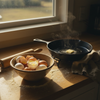DIY Sugar Wax Recipe: Smooth Skin the Natural Way
The Sweet Science of DIY Sugar Waxing: Smooth Skin the Natural Way
Let's talk about that moment when you realize your favorite salon charges more for a wax than your weekly grocery bill. Been there? Same. But what if I told you that the secret to silky-smooth skin has been hiding in your pantry all along? That's right—sugar, water, and lemon juice are about to become your new beauty best friends.
At DI ORO, we're all about empowering you to create something memorable, whether that's a perfect soufflé or, in this case, your own professional-grade sugar wax. No forever chemicals, no mysterious ingredients—just pure, natural goodness that would make your grandmother nod in approval.
Sugar waxing (or "sugaring" if you're feeling fancy) isn't just another beauty trend—it's actually an ancient hair removal technique that dates back to the civilizations of Egypt and Mesopotamia. Talk about standing the test of time! And unlike that questionable milk in your fridge, this beauty solution actually gets better with age.
Why Sugar Wax Deserves a Spot in Your Beauty Arsenal

Before we dive into the sticky-sweet details of our sugar wax recipe, let's talk about why you might want to join the sugaring revolution in the first place.
The Sweet Advantages
Traditional waxing can sometimes feel like you're participating in a medieval torture ritual. Sugar waxing, however, is like its more considerate cousin. The sugar mixture only adheres to your hair and dead skin cells—not live skin—which means less ouch-factor and more "did that actually just happen?" moments.
Plus, sugar wax is water-soluble. Accidentally got some in your eyebrow? No problem! A quick rinse and you're back in business. Try doing that with regular wax without looking like you've been in a fight with a glue stick.
Your Wallet Will Thank You
Let's do some quick math. A professional sugar wax session can cost anywhere from $30-$100, depending on the area. Our DIY sugar wax recipe? About $2 worth of ingredients that you probably already have. Even if you splurge on organic sugar and fresh lemons for your sugar wax kit, you're still saving enough to justify that fancy coffee habit.
For more insights into sugar waxing, visit Cleveland Clinic's guide on sugaring and Medical News Today's article on sugar wax.
Gathering Your Sugar Wax Recipe Ingredients
Ready to channel your inner alchemist? For the best sugar wax recipe, you'll need surprisingly few ingredients—most of which are probably sitting in your kitchen right now, wondering when they'll get to be part of something more exciting than Tuesday night's dinner.
The Essential Three
- 2 cups of white granulated sugar (the same stuff you put in your coffee)
- ¼ cup of lemon juice (fresh is fantastic, but bottled works too)
- 2 tablespoons of water (nothing fancy needed here)
That's it! Though if you're feeling adventurous, some sugar wax recipe variations include a pinch of salt or a tablespoon of honey for extra pliability. And if life gave you no lemons, don't worry—a sugar wax recipe without lemon is possible by substituting with apple cider vinegar.
Tools of the Trade
While you could technically make do with just about any kitchen implements, having the right tools makes the process as smooth as the skin you're aiming for:
- A medium-sized, heavy-bottomed saucepan (the even heat distribution is key)
- A candy thermometer (optional but helpful for precision)
- A heat-resistant container for storage (a mason jar works beautifully)
- A DI ORO Seamless Silicone Spatula (because nothing's more frustrating than leaving half your precious sugar wax stuck to the pan)
Our award-winning spatulas aren't just for folding cake batter—they're perfect for this beauty DIY too. With heat resistance up to 600°F and a completely non-toxic, forever-chemical-free composition, they're the ideal tool for scraping every last bit of that golden sugar mixture into your storage container. America's Test Kitchen didn't name us their Best All-Purpose Spatula for nothing!
Perfecting Your Sugar Wax Consistency

Here's where the magic happens—and where many first-timers go astray. Creating a sugar wax recipe with no strips needed requires achieving that perfect honey-meets-taffy consistency. Too runny and it won't grip the hair; too hard and you'll be chipping away at what's essentially homemade hard candy.
The Sugar Waxing Process: Turning Pantry Staples into Salon-Quality Results
Now that you've assembled your ingredients for the best sugar wax recipe, it's time to transform those humble pantry staples into liquid gold. This is where your sugar wax journey gets deliciously scientific—think of yourself as part chef, part chemist, creating a concoction that would make both Ina Garten and Marie Curie proud.
Cooking Your Sugar Wax to Perfection
Pour your sugar, lemon juice, and water into your saucepan and place it over medium heat. This is where your DI ORO Seamless Silicone Spatula really shines—its heat-resistant properties mean you can stir without worry, while the flexible edge ensures no sugar crystals hide along the sides of your pan.
Resist the urge to constantly stir! Unlike risotto, sugar wax actually benefits from minimal disturbance during the initial melting phase. Once the mixture begins to bubble, give it an occasional gentle swirl with your spatula to prevent hot spots.
As the mixture cooks, you'll notice it transitioning from cloudy white to a gorgeous amber color—like watching a sunset in fast-forward. This visual transformation is your first clue that magic is happening.
The Critical Temperature Window
For a sugar wax recipe that works beautifully without strips, temperature is everything. You're aiming for the "soft ball stage" in candy-making terms—about 240-250°F on your candy thermometer. If you're going thermometer-free, you'll know you're close when the mixture turns a rich honey color.
Too cool, and your sugar wax won't have enough grip to remove hair effectively. Too hot, and you'll end up with something better suited for making lollipops than smooth legs. It's a Goldilocks situation—you want it just right.
The Cooling Test: Is Your Sugar Wax Ready?

Here's where patience becomes your best friend. Once your mixture reaches that perfect amber hue, remove it from heat and transfer it to your heat-resistant container using your DI ORO spatula—getting every last valuable drop. Let it cool for about 10 minutes.
Now for the moment of truth—the cooling test. Take a small amount between your fingers (careful, it should be warm but not burning hot) and roll it into a ball. If it's the right consistency, it should be pliable like soft modeling clay and pull slightly when you press it between your fingers.
If your sugar wax is still too runny, you can return it to heat for another minute or two. If it's hardened into something resembling actual candy, you'll need to start over—but don't worry, we've all been there. Consider it a learning experience (or an opportunity to make some impromptu hard candy).
Troubleshooting Your Sugar Wax Recipe
Creating the perfect sugar wax kit at home might take a couple of attempts, and that's completely normal. Here are some common issues and how to fix them:
- Too runny: Cook it a bit longer or add a sprinkle more sugar
- Too brittle: Start over with less cooking time, or try adding a teaspoon of honey to your next batch
- Crystallized: Avoid stirring too much during the initial melting phase
- Burned: Lower your heat next time and keep a closer eye on that color change
Discover more about the nuances of making perfect mixtures with our Sourdough Starter Recipe.
Application Techniques: Making Your Sugar Wax Work For You
Once you've achieved that perfect consistency, it's time to put your sugar wax recipe to work. Unlike commercial waxing that requires special strips, the beauty of this sugar wax recipe (no strips needed!) is that it's self-contained—the wax itself is both the applicator and the remover.
First, make sure your skin is clean, dry, and lightly dusted with cornstarch or baby powder. This helps the sugar wax grip the hair rather than your skin. Take a small amount of your cooled wax and work it between your fingers until it becomes opaque and pliable.
Apply the wax against the direction of hair growth with a firm, decisive motion. Then—here's the key difference from traditional waxing—pull it OFF in the direction of hair growth. This counter-intuitive technique is actually less painful and more effective, making your sugar wax kit experience much more pleasant than conventional waxing.
For more tips on creating effective natural recipes, check out our Lemon Dill Yogurt Sauce guide.
Reusing Your Sugar Ball
One of the most satisfying aspects of using a sugar wax recipe without lemon (or with it!) is the ability to reuse your sugar ball multiple times during a single session. After pulling, simply knead the used wax back into a ball and continue. It's like getting multiple wax strips in one—economical and eco-friendly!
When your sugar ball starts losing its grip (usually after 3-4 pulls), simply grab a fresh portion from your container and continue. Your homemade sugar wax will stay usable for weeks when stored properly in an airtight container.
Our Kale Egg Bake recipe offers more insights on reusing ingredients effectively.
The Post-Waxing Ritual: Caring For Your Newly Smooth Skin

You've mastered the perfect sugar wax recipe and successfully removed unwanted hair—congratulations! But your sugar waxing journey doesn't end there. Proper aftercare is crucial for maintaining that baby-smooth feeling without irritation. Think of this as the encore to your sugar waxing performance—less dramatic than the main event, but essential for a standing ovation.
First things first: soothe your freshly waxed skin with a gentle, alcohol-free toner or witch hazel to close pores and prevent bacteria from crashing your post-wax party. Your skin has just gone through quite an experience, so treat it with the same care you'd give a soufflé fresh from the oven—gently and with attention.
Natural Aftercare Solutions
Since you've gone the natural route with your sugar wax recipe, why not continue the theme with your aftercare? Aloe vera gel stored in the refrigerator offers cooling relief that feels like heaven on freshly waxed skin. A light application of coconut oil or jojoba oil 24 hours after waxing helps nourish the skin without clogging pores—just use your DI ORO Silicone Spatula to scoop the perfect amount without contaminating the rest.
For the first 24-48 hours post-wax, avoid hot baths, saunas, steam rooms, or vigorous exercise. Your pores are still open and vulnerable—like leaving your front door wide open during a mosquito convention. Also, keep direct sunlight away from freshly waxed areas, as your skin will be more susceptible to UV damage.
For a relaxing treat after your waxing session, you might enjoy reading about our Designer Series, which explores the intersection of functionality and aesthetics.
Maintaining Your DIY Sugar Wax Kit
The beauty of creating your own sugar wax kit at home is that your leftover wax doesn't go to waste. Unlike commercial products that dry out or degrade quickly, properly stored sugar wax can last for months. Store your creation in an airtight glass container at room temperature—no need for refrigeration.
When you're ready to use it again, simply warm it in a microwave for 10-second intervals or place the container in warm water until it reaches that perfect pliable consistency. It's like having a time capsule of smooth-skin potential waiting patiently on your shelf!
For more culinary adventures, take a look at our delightful Bubble Waffle recipe—a perfect complement to your DIY skills.
Perfecting Your Sugar Wax Recipe Over Time
Like any culinary endeavor, your sugar wax recipe will evolve as you gain experience. Maybe you'll discover that a sugar wax recipe without lemon works better for your sensitive skin, substituting apple cider vinegar instead. Perhaps you'll find that adding a drop of lavender essential oil brings a calming element to your waxing routine.
Keep notes on what works best for you—temperature, cooking time, consistency—and soon you'll have a signature sugar wax recipe that rivals any professional formula. It's your kitchen, your skin, your rules!
Why Your Homemade Sugar Wax Deserves the Best Tools
When crafting the best sugar wax recipe at home, using quality tools makes all the difference. Our award-winning DI ORO Seamless Silicone Spatulas—recognized by America's Test Kitchen and Food Network—are the perfect companion for your sugar waxing adventure. Their heat-resistant properties (up to 600°F) mean you can stir your molten sugar mixture with confidence, while the forever-chemical-free silicone ensures nothing unwanted touches your skin-care creation.
The precision edge of our spatulas helps you achieve the exact consistency needed for effective hair removal, and the stainless steel core provides the strength to work with even the thickest sugar wax mixtures. When you're investing time in creating something that directly touches your skin, why compromise on the tools that help you make it?
Embracing the Sugar Waxing Lifestyle
Once you've mastered your homemade sugar wax recipe, you'll find yourself joining a community of DIY beauty enthusiasts who appreciate the ritual almost as much as the results. There's something deeply satisfying about creating an effective beauty product from ingredients so simple you could (technically) eat them.
Many sugar waxing converts report that their hair grows back finer and sparser over time—a welcome bonus to the immediate smooth results. Plus, knowing exactly what's in your hair removal product brings peace of mind that commercial alternatives rarely offer. For further research, visit this scientific study on hair removal techniques.
Conclusion: Your Sugar Waxing Journey
From ancient Egyptian beauty secrets to your modern bathroom, sugar waxing represents beauty tradition at its most accessible and effective. With just a few simple ingredients, some patience, and the right tools, you've created a professional-quality hair removal system that's gentle on your skin, your wallet, and the environment.
Remember that perfecting your sugar wax recipe is a journey, not a destination. Each batch teaches you something new about temperature, timing, and technique. Before long, you'll be the friend everyone comes to for smooth-skin advice and your signature sugar wax recipe.
So go ahead—show off those silky-smooth results with pride. You've joined the ranks of DIY beauty alchemists who know that sometimes, the most effective solutions are also the simplest. Your skin (and your budget) will thank you for mastering this ancient art with a modern twist. For more amazing kitchen tools, visit our Kitchen Utensils Collection and Best Sellers page.
Frequently Asked Questions
How do you make homemade sugar wax?
To make homemade sugar wax, combine sugar, water, and lemon juice in a saucepan. Heat the mixture over medium heat, stirring constantly until it reaches a golden-brown color and a honey-like consistency. Allow it to cool slightly before using it for hair removal.
What is the ratio of sugar wax ingredients?
The typical ratio for sugar wax ingredients is 1 cup of granulated sugar, 1/4 cup of lemon juice, and 1/4 cup of water. This balance ensures the right consistency and effectiveness for hair removal.
What is the 24 hour rule after sugaring?
The 24-hour rule after sugaring advises avoiding activities that may irritate the skin, such as hot showers, sunbathing, and exercising. This period allows the skin to calm down and reduces the risk of inflammation or ingrown hairs.
How do you make 3 ingredient wax?
To make a 3 ingredient wax, mix 1 cup of sugar, 1/4 cup of lemon juice, and 1/4 cup of water in a pot. Heat the mixture over medium heat until it caramelizes into a thick, amber-colored paste, then let it cool slightly before use.
Is lemon juice necessary for sugar wax?
Lemon juice is often used in sugar wax recipes as it helps to stabilize the mixture and acts as a natural preservative. However, if you have sensitive skin, you can substitute it with vinegar or omit it, although the wax may not last as long.
Can you sugar wax your privates?
Yes, you can sugar wax your privates, but it requires careful technique to avoid irritation. It's important to ensure the wax is at a safe temperature and to pull the skin taut during application to minimize discomfort and achieve better results.
-
Posted in
best sugar wax recipe




